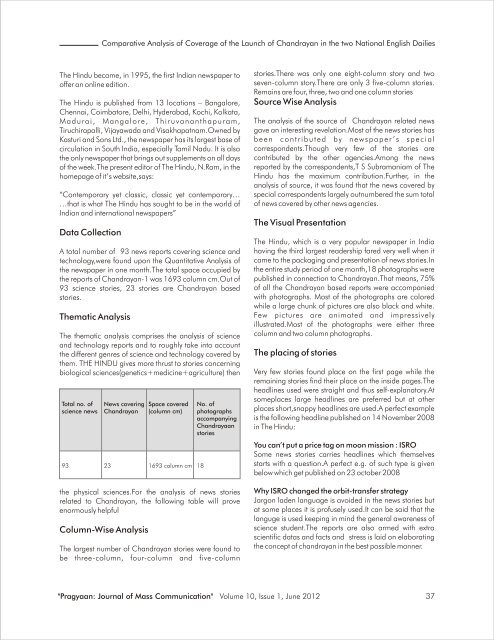Research Papers/Articles - Institute of Management Studies Dehradun
Research Papers/Articles - Institute of Management Studies Dehradun
Research Papers/Articles - Institute of Management Studies Dehradun
Create successful ePaper yourself
Turn your PDF publications into a flip-book with our unique Google optimized e-Paper software.
The Hindu became, in 1995, the first Indian newspaper to<br />
<strong>of</strong>fer an online edition.<br />
The Hindu is published from 13 locations – Bangalore,<br />
Chennai, Coimbatore, Delhi, Hyderabad, Kochi, Kolkata,<br />
Madurai, Mangalore, Thiruvananthapuram,<br />
Tiruchirapalli, Vijayawada and Visakhapatnam.Owned by<br />
Kasturi and Sons Ltd., the newspaper has its largest base <strong>of</strong><br />
circulation in South India, especially Tamil Nadu. It is also<br />
the only newspaper that brings out supplements on all days<br />
<strong>of</strong> the week.The present editor <strong>of</strong> The Hindu, N.Ram, in the<br />
homepage <strong>of</strong> it’s website,says:<br />
“Contemporary yet classic, classic yet contemporary…<br />
…that is what The Hindu has sought to be in the world <strong>of</strong><br />
Indian and international newspapers”<br />
Data Collection<br />
A total number <strong>of</strong> 93 news reports covering science and<br />
technology,were found upon the Quantitative Analysis <strong>of</strong><br />
the newspaper in one month.The total space occupied by<br />
the reports <strong>of</strong> Chandrayan-1 was 1693 column cm.Out <strong>of</strong><br />
93 science stories, 23 stories are Chandrayan based<br />
stories.<br />
Thematic Analysis<br />
Comparative Analysis <strong>of</strong> Coverage <strong>of</strong> the Launch <strong>of</strong> Chandrayan in the two National English Dailies<br />
The thematic analysis comprises the analysis <strong>of</strong> science<br />
and technology reports and to roughly take into account<br />
the different genres <strong>of</strong> science and technology covered by<br />
them. THE HINDU gives more thrust to stories concerning<br />
biological sciences(genetics+medicine+agriculture) then<br />
Total no. <strong>of</strong> News covering Space covered No. <strong>of</strong><br />
science news Chandrayan (column cm) photographs<br />
accompanying<br />
Chandrayaan<br />
stories<br />
93 23 1693 column cm 18<br />
the physical sciences.For the analysis <strong>of</strong> news stories<br />
related to Chandrayan, the following table will prove<br />
enormously helpful<br />
Column-Wise Analysis<br />
The largest number <strong>of</strong> Chandrayan stories were found to<br />
be three-column, four-column and five-column<br />
stories.There was only one eight-column story and two<br />
seven-column story.There are only 3 five-column stories.<br />
Remains are four, three, two and one column stories<br />
Source Wise Analysis<br />
The analysis <strong>of</strong> the source <strong>of</strong> Chandrayan related news<br />
gave an interesting revelation.Most <strong>of</strong> the news stories has<br />
b e e n c o n t r i b u t e d b y n e w s p a p e r ’ s s p e c i a l<br />
correspondents.Though very few <strong>of</strong> the stories are<br />
contributed by the other agencies.Among the news<br />
reported by the correspondents,T S Subramaniam <strong>of</strong> The<br />
Hindu has the maximum contribution.Further, in the<br />
analysis <strong>of</strong> source, it was found that the news covered by<br />
special correspondents largely outnumbered the sum total<br />
<strong>of</strong> news covered by other news agencies.<br />
The Visual Presentation<br />
The Hindu, which is a very popular newspaper in India<br />
having the third largest readership fared very well when it<br />
came to the packaging and presentation <strong>of</strong> news stories.In<br />
the entire study period <strong>of</strong> one month,18 photographs were<br />
published in connection to Chandrayan.That means, 75%<br />
<strong>of</strong> all the Chandrayan based reports were accompanied<br />
with photographs. Most <strong>of</strong> the photographs are colored<br />
while a large chunk <strong>of</strong> pictures are also black and white.<br />
Few pictures are animated and impressively<br />
illustrated.Most <strong>of</strong> the photographs were either three<br />
column and two column photographs.<br />
The placing <strong>of</strong> stories<br />
Very few stories found place on the first page while the<br />
remaining stories find their place on the inside pages.The<br />
headlines used were straight and thus self-explanatory.At<br />
someplaces large headlines are preferred but at other<br />
places short,snappy headlines are used.A perfect example<br />
is the following headline published on 14 November 2008<br />
in The Hindu:<br />
You can’t put a price tag on moon mission : ISRO<br />
Some news stories carries headlines which themselves<br />
starts with a question.A perfect e.g. <strong>of</strong> such type is given<br />
below which get published on 23 october 2008<br />
Why ISRO changed the orbit-transfer strategy<br />
Jargon laden language is avoided in the news stories but<br />
at some places it is pr<strong>of</strong>usely used.It can be said that the<br />
languge is used keeping in mind the general awareness <strong>of</strong><br />
science student.The reports are also armed with extra<br />
scientific datas and facts and stress is laid on elaborating<br />
the concept <strong>of</strong> chandrayan in the best possible manner.<br />
"Pragyaan: Journal <strong>of</strong> Mass Communication" Volume 10, Issue 1, June 2012 37


